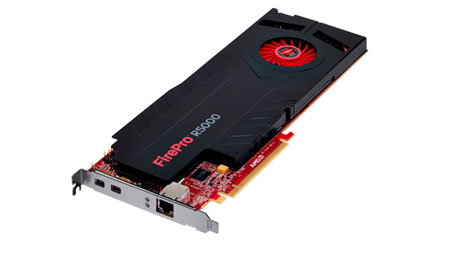
With its built-in Ethernet port and on-board PCoIP compression, the AMD FirePro R5000 can deliver remote 3D graphics over a standard network
Here’s a neat new offering from AMD for design, engineering and manufacturing firms who want remote access to 3D CAD capable workstation technology.
The AMD FirePro R5000 is basically a professional 3D graphics card that has Teradici PC-over-IP (PCoIP) technology built-in. It sits inside a workstation, rack or blade server, and streams highly compressed graphics data over a standard IP network to a thin client that sits on an engineer’s desk.
With AMD’s remote graphics solution no actual CAD data ever leaves the workstation: all of the 3D graphics processing is done on the card, turning snapshots of the CAD model into pixel data. This data is then compressed by the Teradici chip and sent out over Ethernet to be decompressed by the client and displayed on up to four HD monitors. All of this is done frame-by-frame, much like streaming a movie – except in the case of the FirePro R5000 the ‘movie’ is being made in real time as the user manipulates the 3D CAD model on screen.
The big difference from mainstream remote desktop solutions is that the AMD FirePro R5000 is specifically designed for 3D CAD. For the CAD user, the 3D experience should be much the same as working on a local workstation. Move the mouse and the model should instantly react on screen. This, of course, depends on there being suitable bandwidth on the network.
AMD says the technology works with existing networks, though acknowledges there may be benefits to having a dedicated network in place. Depending on the network conditions AMD’s Mohamed Jivraj explains that the on-board Teradici TERA2240 processor will automatically compensate by temporarily reducing the quality of the streamed frames. The most important thing is that system remains responsive to mouse and keyboard input at all times; the CAD model might not be displayed at optimum quality straight away, but the image will sharpen up in subsequent frames – a bit like a progressive JPG on a website.

AMD’s rule of thumb for the required network bandwidth of different usage scenarios
Client side, the AMD FirePro R5000 works with any PCoIP-certified thin client solution, such as those offered by Dell Wyse. AMD says the technology will work with software-based PCoIP clients, such as VMware View [which runs on a PC, tablet or SmartPhone]. However, the best user experience for 3D CAD will usually be with Teradici hardware-based clients as they don’t rely on the CPU for decompression.
The AMD FirePro R5000 is primarily designed for use in a rack or blade server, but with a rating of 150W it can be used in pretty much any desktop workstation.
In addition to an Ethernet port it includes two mini DisplayPorts to drive monitors directly. According to AMD, this will make it easier to remotely diagnose and troubleshoot any issues client side. However, for smaller firms, we imagine it could also give a standard workstation a dual role: a workhorse CAD machine that could also be accessed remotely from the boardroom for interactive presentations.
There are many compelling arguments for remote workstations in general. With a centralised workstation resource ongoing maintenance and support costs can be significantly reduced (upgrades and updates are much easier to manage – no more diving under dusty desks to replace a workstation hard drive).
Data can be kept completely secure with confidential designs protected (CAD data never leaves the workstation – it’s only pixel data that’s ever sent to the thin client).
Office noise can be significantly reduced (imagine a 1,000W workstation with fans on full pelt versus a passively cooled thin client).
It’s also possible to access expensive high-performance workstation technology in hostile environments (workstation fans expel heat but also draw in dust from the shop floor which can damage the machine).
Of course, remote graphics for CAD is nothing particularly new. Rack workstations have been available from Tier One workstation vendors for some time.
However, many of these deploy two discrete PCI Express boards – one for graphics and one for PCoIP. In contrast, the AMD FirePro R5000 is an elegant one-card solution, with a single driver installation and quick setup.
In terms of 3D performance, the FirePro R5000 is a big step up from the ATI FirePro RG220, the entry-level remote graphics offering that AMD released in 2010. With the equivalent performance of a desktop FirePro W5000 GPU the new card should hit the sweet spot for most mainstream CAD applications, including SolidWorks and Inventor – even PTC Creo and Siemens NX. We look forward to test-driving one soon.
Finally, it’s important to note that the AMD FirePro R5000 is all about a one-to-one connection between workstation/server and client; the card can’t be virtualised to enable multiple users to share GPU resources. For this you’ll need the AMD FirePro S9000 or S7000 server graphics solutions or Nvidia GRID (formally VGX)






